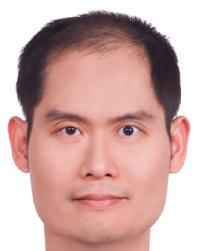郭柏齡 Po-Ling Kuo
Attending Physician in the rehabilitation department at the National Taiwan University Hospital
主要研究領域:
生物物理、力學生物學、生物力學、組織工程﹑醫用超音波Major Research Areas:
Biophysics, Mechanobiology, Biomechanics, Tissue engineering, Medical ultrasound研究領域摘要:
Research Summary:
Mechanobiology is a new field focusing on understanding how living organisms generate, sense, and respond to various mechanical stimuli, which are believed to play a key role in numerous physiological and pathological processes, such as tissue development, tissue repairing, atherosclerosis, cardiac hypertrophy, and cancer progression. My researches primarily focus on the fundamental mechanisms and clinical applications of mechanobiology. Specifically, we investigate the effects of hydrostatic pressure and environmental elasticity on cell physiology, how cells remodel the mechanical properties of their environment, and develop tools quantitatively evaluate the mechanics of cell-matrix interactions. Our previous achievements and ongoing projects include
1. Elucidate the role of hydrostatic pressure on cell physiology
Hydrostatic pressure is an important physical factor in tissue physiology and pathology. We investigated how hydrostatic pressure affects muscle differentiation, immunological activities, cell motility, and cancer invasiveness. Currently we are working on the possible biological signaling pathways involving these processes.
2. Evaluate the effects of multiple biophysical and biochemical stimuli on cell physiology
The cells in vivo are generally exposed to the coexistence of multiple biophysical and biochemical cues. Knowledge of how cells response to these complex stimuli is important for many disciplines such as regenerative engineering and cancer biology. Using BioMEMS techniques, we have developed several platforms allowing the coexistence of mechanical, electrical, and chemical stimuli for cultured cells. Currently we are delineating the antagonistic and agonistic roles between these stimuli.
3. Develop a 3D cell culture system that allows quantitatively accessing the mechanics of cell-matrix interactions
The changes of mechanical properties such as stiffness of a tissue usually are hallmarks of various physiological and pathological processes, such as arthrosclerosis and tumor malignant transformation. In vitro assays quantitatively measuring the mechanics of cell-matrix interactions are of great importance to understand the mechanisms and facilitate the development of corresponding therapeutic strategies of these processes. Cells cultured in a 3D environment behave far different from that cultured in 2D and recapitulate more physiological characteristics in vivo. An important ongoing project in our lab is to develop a 3D cell culture system using state-of-the-art imaging and scaffold fabrication techniques to quantitatively access the mechanics of live cell-matrix interactions.
4. Develop clinical tools for treatment and monitoring of the mechanical dysfunction of dense connective tissues
Mechanical malfunction of dense fibrous tissues usually leads to protracted and debilitating conditions, such as joint capsule contracture, tissue fibrosis, and tendinosis. Our goal is to develop clinical tools that allow treating these disorders non-invasively, while the change of mechanical function of the diseased tissues can be non-invasively and quantitatively monitored. We have combined the state-of-the-art ultrasonic techniques and developed a prototypical system for this purpose. Our ongoing project is to evaluate its effectiveness in various clinical conditions.

-
B.S.
National Taiwan University, 1994 -
M.S.
National Taiwan University, 1998 -
Ph.D.
Harvard University, 2008
-
Address
MD-519,
Department of Electrical Engineering,
National Taiwan University,
Taipei 106, Taiwan -
Phone
+886-2-33669882 -
Email:

-
Office Hour
Thus 10:00-12:00